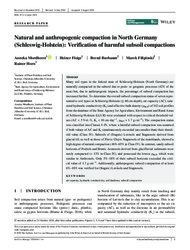Natural and anthropogenic compaction in North Germany (Schleswig-Holstein): Verification of harmful subsoil compactions
DOI: https://doi.org/10.1111/sum.12631
Persistent URL: http://resolver.sub.uni-goettingen.de/purl?gldocs-11858/9089
Persistent URL: http://resolver.sub.uni-goettingen.de/purl?gldocs-11858/9089
Mordhorst, Anneka; Fleige, Heiner; Burbaum, Bernd; Filipinski, Marek; Horn, Rainer, 2020: Natural and anthropogenic compaction in North Germany (Schleswig-Holstein): Verification of harmful subsoil compactions. In: Soil Use and Management, DOI: 10.1111/sum.12631.
 |
Dokument öffnen: |
Many soil types in the federal state of Schleswig-Holstein (North Germany) are naturally compacted in the subsoil due to pedo- or geogenic processes (42% of the area) but, due to anthropogenic impacts, the percentage of subsoil compaction has increased further. To determine the overall subsoil compaction status of seven representative soil types in Schleswig-Holstein (≤ 60 cm depth), air capacity (AC), saturated hydraulic conductivity (Ks) and effective bulk density (ρBeff) of 342 soil profiles from the database of the State Agency for Agriculture, Environment and Rural Areas of Schleswig-Holstein (LLUR) were evaluated with respect to critical threshold values (AC < 5 Vol.-%, Ks < 10 cm day−1, ρBeff > 1.7 g cm−3). The compaction status was classified into Classes I–IV, where a harmful subsoil compaction was assumed if both values of AC and Ks simultaneously exceeded (are smaller than) their threshold value (Class IV). Subsoils of (Stagnic) Luvisols and Stagnosols derived from glacial till, as well as those of Fluvic Gleyic Stagnosols of the marshlands, showed a high degree of natural compaction (46%–65% in Class IV). In contrast, sandy subsoil horizons of Podzols and Brunic Arenosols derived from glacifluvial sediments were rarely compacted (< 13% in Class IV), and possessed the lowest ρBeff, which were similar to Anthrosols. Only 5%–18% of their subsoil horizons exceeded the critical value of 1.7 g cm−3. Additionally, anthropogenic subsoil compaction of at least 6%–10% was verified for (Stagnic) Luvisols and Stagnosols.
Statistik:
ZugriffsstatistikSammlung:
This is an open access article under the terms of the Creative Commons Attribution License, which permits use, distribution and reproduction in any medium, provided the original work is properly cited.

